Have you ever wondered why your phone has three radios (LTE, Wi-Fi and Bluetooth), while your tablet and computer typically have two (Wi-Fi and Bluetooth)? For that matter, why do you know names like Wi-Fi, Bluetooth and LTE? What about 5G or Zigbee?
At the same time that wireless data-communication technology and standards are still in development, new standards and proprietary technologies (like Zigbee) are clamoring for attention. How do we separate the noise from what is real and important? Should consumers care about any of this? Figure 1, below, offers an impression of the variety of wireless technologies that play a role in our daily lives.
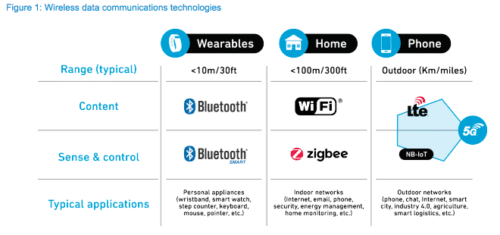
Despite all the marketing chatter, it is relatively easy to look at the bigger picture and understand where things are going. And as it is often the case, it can be helpful to remind ourselves how we got to where we are today.
Maybe a Little Bit of Technology First
There are only three things of overriding importance in radio technology, and we experience them all in our daily lives. These three things are range, data rate and power.
- We experience range as our phone is connected to a base station (or not), or when our laptop is connected to the router at home, or when our headset is connected to our phone. And we all know from experience what happens if a device gets “out of range.”
- We are also quite familiar with data rate, particularly when we watch videos or listen to music. Wi-Fi has been the king of data rate until now, but we have been able to receive similar data rates with LTE and 5G – though perhaps at a higher price.
- Finally, while we have grown accustomed to regularly recharging our phones and laptops, we are reminded of the importance of power consumption in those annoying moments when we discover that our smaller devices, like headsets or Fitbits, are not charged when we are ready to use them.
These three items fit together in an interesting way, a sort of basic law of physics. Try to improve one, and the two others must give way. Of course, general overall improvements have been made over time on all three, but the relationship between them is the same.
For instance, if you want increased data rate, then you must either lose range or increase the output power. Wi-Fi today, with its higher speeds (data rate), has less range than in the past and more often needs repeaters – this is one of the motivators for distributed Wi-Fi, or mesh Wi-Fi. This same relationship holds true for Zigbee (“low power Wi-Fi”). It essentially gets the same range as Wi-Fi, at a low data rate, but with significantly lower power, thereby achieving a very long battery life.
 There is a fourth element in this equation, also based on physics, that we may be less aware of in our daily lives. That element is frequency. Higher frequencies reduce range or require higher power to achieve the same range. But higher frequencies have the advantages of more bandwidth and, thus, higher data rates. This explains the tendency for higher data rates to “look for” higher frequencies. The newest versions of Wi-Fi are in the 60 GHz frequency band, with targets up to 100 Gb/s (.11ay).
There is a fourth element in this equation, also based on physics, that we may be less aware of in our daily lives. That element is frequency. Higher frequencies reduce range or require higher power to achieve the same range. But higher frequencies have the advantages of more bandwidth and, thus, higher data rates. This explains the tendency for higher data rates to “look for” higher frequencies. The newest versions of Wi-Fi are in the 60 GHz frequency band, with targets up to 100 Gb/s (.11ay).
Back to the Radios Present in Phones and Laptops
Clearly a lot more can be said about this, but to a large extent, these parameters are the reasons you have three radios in your phone. One radio (LTE) to get the range to connect to the closest base station in your neighborhood; one radio (Wi-Fi) to get performance when you are at home or in the office; and one radio (Bluetooth) to enable short-range connectivity to the small devices that you carry with you, like your phone headset or your Fitbit.
Why, then, do laptops and tablets usually only have two radios? There is a logical answer, but we must also understand a bit of history.
A Brief History: the Technology Players
In a relatively short period of time, we have seen three new technologies develop and converge:
- The phone, to remotely connect us via low-speed data communications.
- Radio/TV, to broadcast audio/video, via cable or satellite, with one-way high-speed data communications.
- The computer, including two-way high-speed networking that pulls everything together. All the communication was initially over a wired cable (copper or fiber), but when the convenience of wireless came along, it became ubiquitous.
 As technology progresses, the differences between phones, TVs, laptops and tablets are slowly disappearing. In a way, they are all becoming “networked computers,” but each still has its own history of wireless communication standards as each experienced its own transition from wired to wireless technology. Phones and computers had a more dynamic path, but because TVs are largely static (nonmobile) devices, the cable/satellite industry mostly stayed in its own wired world.
As technology progresses, the differences between phones, TVs, laptops and tablets are slowly disappearing. In a way, they are all becoming “networked computers,” but each still has its own history of wireless communication standards as each experienced its own transition from wired to wireless technology. Phones and computers had a more dynamic path, but because TVs are largely static (nonmobile) devices, the cable/satellite industry mostly stayed in its own wired world.
As phones became more computer-like (i.e., smart phones), and computers began supporting all kind of video- and phone-like communication capabilities, it should come as no surprise that the variety of networking technologies that have developed, past and present, are sometimes at odds.
Different Networking Technologies Standards – Developing Very Differently
The standardization body for wireless phone communication today is 3GPP; for wireless computer data communication, it is IEEE 802.11. The roots of 3GPP are with the telephone operators and their governmental sponsors, since operators were originally governmental bodies. (In some countries, they still are.) The IEEE 802.11 is rooted in the computer industry. In addition to academics and regulators, IEEE 802.11 has a large engineer membership, most of whom are sponsored by their employer companies.
The IEEE 802.11 and the 3GPP had another complete and fundamental difference. The government-sponsored 3GPP worked licensed spectrum – spectrum that could be acquired for a certain amount of time to provide communication services. The government, as licensor of the spectrum, is responsible for making sure that the spectrum can only be used by the licensee. Not so with the IEEE 802.11. This standardization body has developed standards in the “unlicensed” bands – bands that have been set aside by the government for “free usage,” based on a set of rules with limited power, so that the interference range for realistic applications stays local. These bands are called ISM (Industrial, Scientific and Medical) bands and can be found in the 2, 5 and 60 GHz bands.
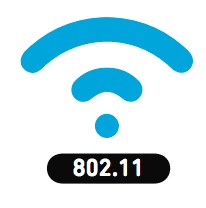 The companies that sponsored their engineers to develop IEEE 802.11 then needed to enforce compliance to the IEEE 802.11 standard definitions. (The IEEE 802.11 itself does not regulate compliance.) So, the Wi-Fi Alliance was founded by these interested companies for enforcing and promoting the IEEE 802.11 standard under the Wi-Fi brand – without exaggeration one of the most valuable brands today. 3GPP, on the other hand, never really focused on a cohesive brand strategy aimed at consumers. This makes sense because 3GPP was the interest group of operators, who always had a certain control of the market. They never had to win the hearts and minds of the consumers, like Wi-Fi and Bluetooth did. So instead of bothering with brand consistency issues, whole sets of ever-improving standards migrated from GSM/GPRS to 3G, Edge, 4G, LTE and now 5G, which will likely involve a new set of implementations.
The companies that sponsored their engineers to develop IEEE 802.11 then needed to enforce compliance to the IEEE 802.11 standard definitions. (The IEEE 802.11 itself does not regulate compliance.) So, the Wi-Fi Alliance was founded by these interested companies for enforcing and promoting the IEEE 802.11 standard under the Wi-Fi brand – without exaggeration one of the most valuable brands today. 3GPP, on the other hand, never really focused on a cohesive brand strategy aimed at consumers. This makes sense because 3GPP was the interest group of operators, who always had a certain control of the market. They never had to win the hearts and minds of the consumers, like Wi-Fi and Bluetooth did. So instead of bothering with brand consistency issues, whole sets of ever-improving standards migrated from GSM/GPRS to 3G, Edge, 4G, LTE and now 5G, which will likely involve a new set of implementations.
The Battles and Successes of Wi-Fi – and the Answer to Why Computers Have Two Radios
When Wi-Fi was emerging in the late 1990s, the general tendency in “3GPP-land” was to ask: why do you need Wi-Fi? At that time, the standardization of 3G was progressing well and promising high data rates, and 3Gmodems connected to or integrated in laptops would provide ubiquitous connectivity. So, why bother with Wi-Fi? The general opinion was that this “unlicensed technology” would disappear, probably sooner than later, because in the unlicensed bands, the lack of oversight would bring the performance spiraling down quickly.
Of course, we know today that things turned out rather differently. Wi-Fi has found a way to properly operate in the unlicensed ISM-bands and satisfy the needs for wireless connectivity indoor, in-home or in-building, where 3G was not able to penetrate well. Also, Wi-Fi rapidly increased its data rate and expanded its capabilities by moving from the 2.4 GHz band into the 5 GHz band, and it is expected to further extend these by going into the 6o GHz band. Range extender technologies and, more recently, the concept of distributed Wi-Fi (“Wi-Fi Mesh”), have also supported Wi-Fi’s success to date.
A significant part of the reason that Wi-Fi was successful was the fact that data communications via 3G required a paid subscription from telephone operators and a data plan that initially led to quite hefty bills, not to mention roaming charges. By comparison, Wi-Fi was free – or at least, the incremental cost for Wi-Fi via a fixed telephone, ISDN and later with ADSL, was limited.
So now we had wired operators directly competing with the wireless operators, which ultimately stimulated worldwide acceptance of Wi-Fi. The wireless operators helped this along by initially discouraging the use of 3G for data (and therefore encouraging the use of Wi-Fi) due to concern for a voice service collapse if 3G was “overused” for data. By marketing 3G as having a data element, even though it really was designed for voice, the 3G folks didn’t help themselves in this regard.
By the way, this answers the question of why most computers and tablets have only two radios. 3G-licensed radios (and their successors) were rarely integrated in computers or tablets because Wi-Fi offered a cost-effective and versatile internet connection. An integrated 3G radio was just too expensive by comparison. When a mobile solution is needed, users have turned to devices like 3G dongles or, more commonly today, using their mobile phone as a hotspot.
Wi-Fi Versus Bluetooth (and Now Zigbee)
At the same time the battle between Wi-Fi and 3G unfolded, another battle emerged. Several companies that were suppliers to the telephone industry (notably Ericsson and Nokia) saw another usage for ISM bands – to improve phone connectivity when connecting to a hotspot for information downloads and when connecting wireless headsets and other devices to the phone. To create a standard for type of phone connectivity, the Bluetooth SIG (Special Interest Group) was formed, with companies as members (as opposed to the engineer members of IEEE 802.11). Fairly soon, the Bluetooth SIG echoed 3GPP in declaring Wi-Fi redundant and telling the market Wi-Fi would soon disappear.
Again, not so much. After a few years, it became clear that Wi-Fi and Bluetooth had separate, defined application domains – Wi-Fi for “networking” and Bluetooth for “peripheral connectivity.” Since then, many devices have emerged with both Wi-Fi and Bluetooth – Wi-Fi for high-speed networking and Bluetooth for connecting devices. For a while, there was an effort to make Bluetooth part of IEEE, but their organizational and membership differences drove them apart.
Interestingly, there is a sequel of this battle in the works today. Zigbee, the low-power variant of Wi-Fi (based on IEEE 802.15.4) is under threat from BLE (Bluetooth Low Energy), the low-power variant of Bluetooth. The Bluetooth SIG is developing a networking variant (Bluetooth Mesh) that is supposed to compete with Zigbee. Looking at the early proposals, however, it seems that considerable complexity would need to be added to BLE to achieve what is already available with Zigbee. We will have to wait and see how this plays out.
Spectrum Availability
The evolution of these wireless technologies was made possible by growing amounts of radio spectrum made available by the worlds’ regulatory authorities. Figures 2 and 3, below, give rough indications of the major technologies and frequency bands involved. At the 2019 World Radio Conference, significant new allocations are expected for Wi-Fi and 5G to support the increasing demands for wireless data communications. The exact details of spectrum availability and usage conditions is beyond the scope of this paper.
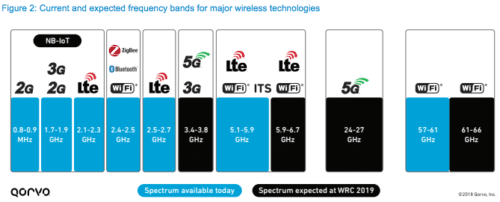
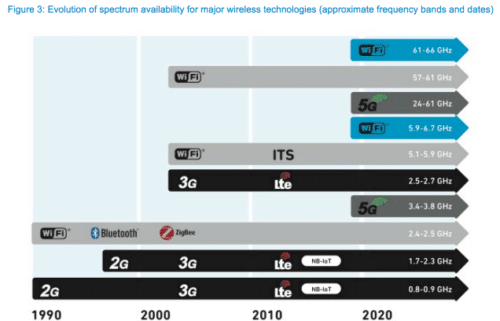
Telephone Operators and Wi-Fi…Working Together?
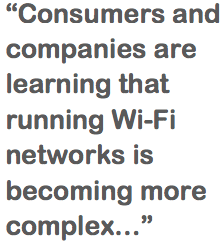 One would think that after 3G and Wi-Fi fought their battles, the demarcations between the two technologies would be clear – Wi-Fi for private areas (home, office) and 3G everywhere else. But, no. Initially the telephone operators in 3GPP were naturally quite suspicious about the development of so-called “hotspots,” public places where people could get access to high speed internet without the need for a subscription. Fortunately for the telephone operators, it turned out that running a large number of hotspots was not a trivial effort, in particular for large retail and hotel chains, cities, trains, etc. Public hotspot companies have been slowly absorbed by the telephone operators, who started to further embrace Wi-Fi and learned that “unlicensed” was not as bad as it sounded. Operators even developed strategies to use public hotspots along with private routers to “off-load.” In other words, use Wi-Fi connected hotspots for traditional phone services. At the same time, consumers and companies are learning that running Wi-Fi networks is becoming more complex, and telephone operators (and more recently, also cable operators) are finding out that private Wi-Fi networks are business opportunities – helping consumers and smaller companies run their Wi-Fi networks.
One would think that after 3G and Wi-Fi fought their battles, the demarcations between the two technologies would be clear – Wi-Fi for private areas (home, office) and 3G everywhere else. But, no. Initially the telephone operators in 3GPP were naturally quite suspicious about the development of so-called “hotspots,” public places where people could get access to high speed internet without the need for a subscription. Fortunately for the telephone operators, it turned out that running a large number of hotspots was not a trivial effort, in particular for large retail and hotel chains, cities, trains, etc. Public hotspot companies have been slowly absorbed by the telephone operators, who started to further embrace Wi-Fi and learned that “unlicensed” was not as bad as it sounded. Operators even developed strategies to use public hotspots along with private routers to “off-load.” In other words, use Wi-Fi connected hotspots for traditional phone services. At the same time, consumers and companies are learning that running Wi-Fi networks is becoming more complex, and telephone operators (and more recently, also cable operators) are finding out that private Wi-Fi networks are business opportunities – helping consumers and smaller companies run their Wi-Fi networks.
And finally, with the further rapid growth of data traffic, especially via video applications like YouTube, the operators need increased capacity. But getting more frequency bands is not easy. A faster way of getting this capacity, next to leveraging Wi-Fi, was realizing that the successor of 3G, 4G or LTE technology can also run in the ISM band. This realization gave rise to the concept of LTE-LAA – LTE with Licensed Assisted Access. The 3GPP specifications allow both Wi-Fi and LTE-LAA to be used in the same 5 GHz spectrum. The first installations of LTE-LAA are being planned now, but we will have to wait and see if LTE-LAA is a hit.
So, What’s Happening Now, and What Happens Next?
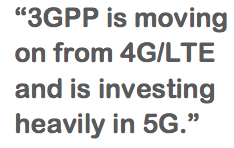 Armed with this understanding of history, we can see a new battle is looming. The IEEE 802.11 has been working diligently on higher-speed versions –.11n and .11ac, and it is in the process of completing .11ax. At the same time, the 3GPP is moving on from 4G/LTE and is investing heavily in 5G. (As an aside, the Wi-Fi Alliance is doing a great marketing job by calling everything higher speed Wi-Fi, while 3GPP continues to be technology-driven, making the different generations explicit and creating disruptions that are detrimental for a smooth migration.)
Armed with this understanding of history, we can see a new battle is looming. The IEEE 802.11 has been working diligently on higher-speed versions –.11n and .11ac, and it is in the process of completing .11ax. At the same time, the 3GPP is moving on from 4G/LTE and is investing heavily in 5G. (As an aside, the Wi-Fi Alliance is doing a great marketing job by calling everything higher speed Wi-Fi, while 3GPP continues to be technology-driven, making the different generations explicit and creating disruptions that are detrimental for a smooth migration.)
In any case, it should now not come as a surprise that the talk is (again) about which technology is going to win. 5G or IEEE 802.11ax? Both will be in the high data rates (Gb/s), and both will be quite power intensive to get good range, and both are trying to infringe on each other’s territory. 5G is claiming that it will have “way better indoor penetration”, and .11ax is throwing out the slogan, “5G has arrived and it is called .11ax.”
IEEE 802.11ax has a clear path worked out, although with the increased data rate, the range is definitely reducing. Interestingly Wi-Fi has turned this disadvantage into an advantage by focusing this new IEEE 802.11ax standard on distributed Wi-Fi (Wi-Fi Mesh) and enabling the usage of multiple channels at the same time to connect multiple access points in different rooms to the main router. The focus of IEEE 802.11ax is on full indoor coverage – every nook and cranny in your house or office building covered with the same high data rate, creating an experience that will not be easily replaceable with 5G. (Lest this sounds too good to be true, IEEE 802.11ax turns out to be a very difficult standard, and its completion has just been delayed by another six months, with ratification now expected in early 2019.)
However, 5G is facing its own quite serious challenges, including delays. 5G’s higher data rates create a penalty on its range, too, and for cellular base stations, coverage goes “by the square.” The expectation is that the range for 5G will probably decrease by less than half, forcing the number of base stations to more than quadruple. In dense urban areas, where finding real estate to place base stations is expensive, this will mean that rolling out 5G infrastructure will be at significant expense, at the same time, that many operators are still recovering from their 4G investments.
Though it varies a bit by country and the financial structure of the telephone operators, the belief is that higher data rates will be needed to sustain the consumer and business appetites for higher data rates, particularly in dense population settings, where the usage of licensed spectrum can be better controlled than unlicensed. So the money flowing into further developing and maturing 5G is continuing, and the first trials are planned for early 2018 around the Winter Olympics in Korea.
Conclusion
So, who is going to win the battle? Honestly, there shouldn’t even be a battle. Both 5G and Wi-Fi have very particular characteristics that will be beneficial for connecting “computers” (including all the devices that can now be classified under this term) to the internet. So, the operator that best can exploit both technologies to its advantage and can define and execute a strategy that leverages them both, will become the winner. Seen from this perspective, the ultimate winner of these technology battles will be the end-user.





